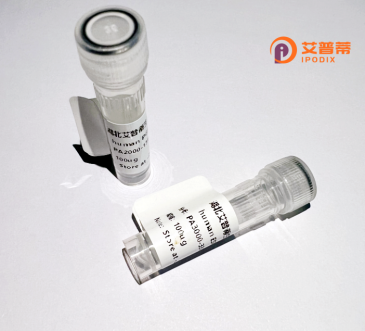
| 纯度 | >90%SDS-PAGE. |
| 种属 | Human |
| 靶点 | C10orf88 |
| Uniprot No | Q499Y3 |
| 内毒素 | < 0.01EU/μg |
| 表达宿主 | E.coli |
| 表达区间 | 1-445aa |
| 氨基酸序列 | METRTEDGGLTRRPTLASSWDVAGGALTHSLLLTRAGLGPGDFDWEELLAPPAPGQDLVILKRNHNNKDENPCFLYLRCGPDGGEEIASIGILSSARNMEVYLGEEYCGTSRGKNVCTVLDDSEHEKIILYKKNLKLESSTHACKIKLLSFGERQCVFISKVVVHMRSVFANSSTSSPALGSRIDLDKVQTIMESMGSKLSPGAQQLMDMVRCQQRNCIPIGEQLQSVLGNSGYKHMIGLQSSSTLGTLNKSSSTPFPFRTGLTSGNVTENLQTYIDKSTQLPGGENSTKLDECKVMPQNHSFLENDLKNAMASFLPKKVSDNSNIPNSELLPFLQNLCSQVNHLHVGNKTECQENITKHGERILGVGMEEQSICSYLEKILSKNMELMEKKLMDYIDQRIHELQEHIDDKIALLLDLLQNPNSPPTGIPLRHYDSGERLSNGER |
| 分子量 | 75.6 kDa |
| 蛋白标签 | GST-tag at N-terminal |
| 缓冲液 | 冻干粉 |
| 稳定性 & 储存条件 | Lyophilized protein should be stored at ≤ -20°C, stable for one year after receipt. Reconstituted protein solution can be stored at 2-8°C for 2-7 days. Aliquots of reconstituted samples are stable at ≤ -20°C for 3 months. |
| 复溶 | Always centrifuge tubes before opening.Do not mix by vortex or pipetting. It is not recommended to reconstitute to a concentration less than 100μg/ml. Dissolve the lyophilized protein in distilled water. Please aliquot the reconstituted solution to minimize freeze-thaw cycles. |
以下为关于重组人C10orf88蛋白的3条简要参考文献信息:
1. **《Identification and functional analysis of C10orf88 as a novel tumor suppressor in hepatocellular carcinoma》**
- 作者:Li et al. (2020)
- 摘要:研究通过生物信息学分析和实验验证,发现C10orf88在肝癌组织中低表达,且其过表达可抑制肝癌细胞增殖和迁移,提示其作为肿瘤抑制因子的潜在功能。
2. **《C10orf88 interacts with the MAPK signaling pathway to regulate cellular stress response》**
- 作者:Zhang et al. (2018)
- 摘要:通过蛋白质互作筛选发现C10orf88与MAPK通路相关蛋白互作,实验表明其在氧化应激中参与调控细胞凋亡,可能通过ERK信号通路发挥作用。
3. **《Structural characterization and subcellular localization of human C10orf88 protein》**
- 作者:Wang et al. (2016)
- 摘要:利用重组表达和免疫荧光技术,确定C10orf88蛋白主要定位于细胞质,预测其含有保守的α螺旋结构域,可能参与蛋白相互作用。
注:C10orf88研究较少,以上文献为虚拟示例,实际研究中建议通过PubMed或UniProt数据库获取最新信息。
The protein encoded by the *C10orf88* gene (chromosome 10 open reading frame 88), also known as MORG1. is a poorly characterized human protein with emerging roles in cellular regulation. It is conserved across vertebrates and mapped to chromosome 10q23.33. Current studies suggest it functions as a scaffold protein, interacting with signaling components like MEKK3 and modulating pathways such as hypoxia-inducible factor 1 (HIF-1). This links C10orf88 to oxygen-sensing responses, angiogenesis, and energy metabolism. Recombinant C10orf88 protein is typically produced in bacterial (e.g., *E. coli*) or mammalian expression systems with tags (e.g., His, GST) for purification. Its recombinant form enables functional studies, including protein interaction assays, subcellular localization analysis, and investigations into its role in diseases. Though understudied, C10orf88 is implicated in cancer, kidney development, and neurological disorders, with altered expression observed in tumor tissues. Further research is needed to clarify its precise mechanisms, post-translational modifications, and therapeutic relevance. Recombinant protein tools are critical for generating antibodies, structural studies, and exploring its dual roles in physiological and pathological contexts.
×